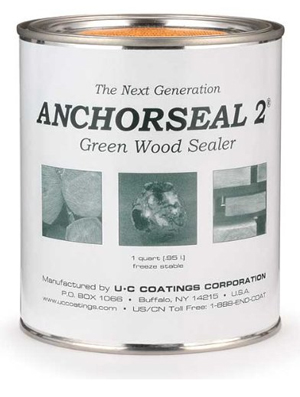
I am a novice “woodworker” and have recently been able to afford a couple of machines that help me. One is a table saw and the other is a thickness planer. I was cutting a couple of trees in my yard that were in the process of dying and using them for firewood. Please note that I am in West/Central Georgia and the amount of firewood that I need is small compared to other parts of the country. I think the lowest daytime temperature is around 48 degrees, but it can get colder during the evening.
One of the trees I cut was a sweet gum (Liquidambar styraciflua), and I noticed some of the wood had a pretty grain pattern to it. The next tree I had to cut down was about 12″ in diameter and, as I only have a chainsaw, I cut the log into 2-foot sections and then tried to slab it in 2″ – 3″ thick sections. I then coated the ends with a latex paint and stacked the wood in my garage (they don’t have basements down here). I used 1 x 1’s for stickers and stacked four sections on top of each other. I kept checking the ends for further checking and, if needed, I applied more latex paint.
After three years, I checked the moisture level, and it was in the 6 to 7 percent range ,so I started looking at what I can make this into. I settled on a Shaker Lap Desk that I have plans for and started working on dimensioning the wood. That is the hard part. Over the three years, the wood has cupped and twisted but little checking, so I can flatten the wood and then joint one side. I used the table saw to cut the pieces into 3-1/4 inches and then 1/2-thick boards. What is nice about this is the ability to book-match the wood for a different appearance.
Now my problem comes in hand-cut dovetails for the frame. I can glue up the panels that are needed for the sides, top and bottom, but I have not made dovetails before. I am using this lumber as a means of learning: it doesn’t cost me anything for the wood other than my time, which I have more of. If nothing else, I will have more kindling and firewood for this coming winter.
A question I would like to ask the other woodworkers doing the same thing is: What could I use to seal the ends of the wood (I cut the tree down in winter so the bark stayed on the wood to help with slowing down the moisture lost) beside latex paint? Also, I was thinking, if I used something like Thompsons® WaterSeal®, would this also help to slow down the rate at which the moisture evaporates to better stabilize the wood so there isn’t so much warping and twisting; or would this allow the moisture to remain inside the wood for too long and spoil a nice-looking piece of wood? – Lee Nalley
Chris Marshall: What a great use of wood you’ve dried yourself, Lee: as a learning aid for trying new woodworking techniques. I’m sure that not having to worry about the dollars you’re “wasting” by experimentation is a nice benefit to backyard lumber. Sounds like your sweet gum is ready for use now, and so there’s no need to treat it further for moisture loss. But going forward, there are specific brush-on products for sealing the end grain of green lumber. Anchor-Seal®, a wax emulsion product, is a common choice, but there are others as well (click here for an option from Rockler). It’s formulated to reduce the checking that happens if moisture leaves the wood too quickly. But it sounds like paint has worked well for you. If your future lumber drying will be for “experiment” lumber again, leftover paint may be all you need for your purposes … and it’s free! I’ve never seen board faces or edges covered with preservative; just stickering it and sheltering the lumber will be sufficient to promote air circulation and encourage slow, productive drying.
Tim Inman: While there are special preparations made especially for sealing the end grain of freshly sawn lumber, just about anything will help. In fact, my old gray cells kicked in and reminded me of a study done by W.C. Feist at Forest Products Research on the University of Wisconsin campus in Madison a long time ago. In it, they studied the “Moisture Excluding Effectiveness” of various coatings. The study determined that there is not a significant difference between coatings, and that multiple coats do not yield linear increases in moisture exclusion. Read: One coat is about as good as two or three. Here is the link, if you’d like to read the study.
Good luck and have fun with your “found” wood.






